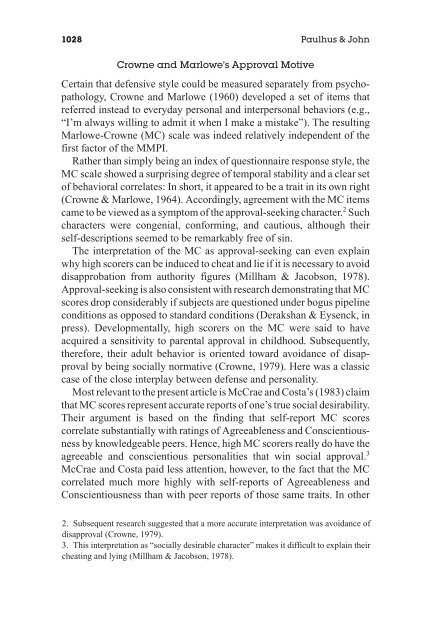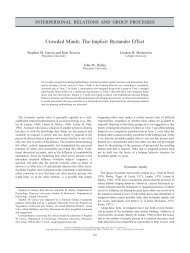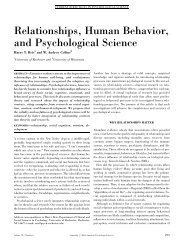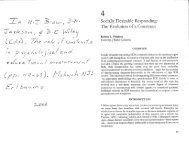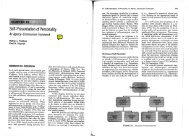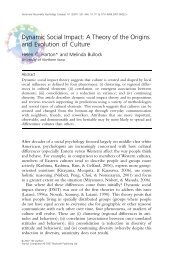Egoistic and Moralistic Biases in Self-Perception - University of ...
Egoistic and Moralistic Biases in Self-Perception - University of ...
Egoistic and Moralistic Biases in Self-Perception - University of ...
Create successful ePaper yourself
Turn your PDF publications into a flip-book with our unique Google optimized e-Paper software.
1028 Paulhus & John<br />
Crowne <strong>and</strong> Marlowe’s Approval Motive<br />
Certa<strong>in</strong> that defensive style could be measured separately from psychopathology,<br />
Crowne <strong>and</strong> Marlowe (1960) developed a set <strong>of</strong> items that<br />
referred <strong>in</strong>stead to everyday personal <strong>and</strong> <strong>in</strong>terpersonal behaviors (e.g.,<br />
“I’m always will<strong>in</strong>g to admit it when I make a mistake”). The result<strong>in</strong>g<br />
Marlowe-Crowne (MC) scale was <strong>in</strong>deed relatively <strong>in</strong>dependent <strong>of</strong> the<br />
first factor <strong>of</strong> the MMPI.<br />
Rather than simply be<strong>in</strong>g an <strong>in</strong>dex <strong>of</strong> questionnaire response style, the<br />
MC scale showed a surpris<strong>in</strong>g degree <strong>of</strong> temporal stability <strong>and</strong> a clear set<br />
<strong>of</strong> behavioral correlates: In short, it appeared to be a trait <strong>in</strong> its own right<br />
(Crowne & Marlowe, 1964). Accord<strong>in</strong>gly, agreement with the MC items<br />
came to be viewed as a symptom <strong>of</strong> the approval-seek<strong>in</strong>g character. 2 Such<br />
characters were congenial, conform<strong>in</strong>g, <strong>and</strong> cautious, although their<br />
self-descriptions seemed to be remarkably free <strong>of</strong> s<strong>in</strong>.<br />
The <strong>in</strong>terpretation <strong>of</strong> the MC as approval-seek<strong>in</strong>g can even expla<strong>in</strong><br />
why high scorers can be <strong>in</strong>duced to cheat <strong>and</strong> lie if it is necessary to avoid<br />
disapprobation from authority figures (Millham & Jacobson, 1978).<br />
Approval-seek<strong>in</strong>g is also consistent with research demonstrat<strong>in</strong>g that MC<br />
scores drop considerably if subjects are questioned under bogus pipel<strong>in</strong>e<br />
conditions as opposed to st<strong>and</strong>ard conditions (Derakshan & Eysenck, <strong>in</strong><br />
press). Developmentally, high scorers on the MC were said to have<br />
acquired a sensitivity to parental approval <strong>in</strong> childhood. Subsequently,<br />
therefore, their adult behavior is oriented toward avoidance <strong>of</strong> disapproval<br />
by be<strong>in</strong>g socially normative (Crowne, 1979). Here was a classic<br />
case <strong>of</strong> the close <strong>in</strong>terplay between defense <strong>and</strong> personality.<br />
Most relevant to the present article is McCrae <strong>and</strong> Costa’s (1983) claim<br />
that MC scores represent accurate reports <strong>of</strong> one’s true social desirability.<br />
Their argument is based on the f<strong>in</strong>d<strong>in</strong>g that self-report MC scores<br />
correlate substantially with rat<strong>in</strong>gs <strong>of</strong> Agreeableness <strong>and</strong> Conscientiousness<br />
by knowledgeable peers. Hence, high MC scorers really do have the<br />
agreeable <strong>and</strong> conscientious personalities that w<strong>in</strong> social approval. 3<br />
McCrae <strong>and</strong> Costa paid less attention, however, to the fact that the MC<br />
correlated much more highly with self-reports <strong>of</strong> Agreeableness <strong>and</strong><br />
Conscientiousness than with peer reports <strong>of</strong> those same traits. In other<br />
2. Subsequent research suggested that a more accurate <strong>in</strong>terpretation was avoidance <strong>of</strong><br />
disapproval (Crowne, 1979).<br />
3. This <strong>in</strong>terpretation as “socially desirable character” makes it difficult to expla<strong>in</strong> their<br />
cheat<strong>in</strong>g <strong>and</strong> ly<strong>in</strong>g (Millham & Jacobson, 1978).


